The aphid is a tiny, soft-bodied insect that spells trouble in the garden. Its salivary secretions are phytotoxic, causing galls to form; disfiguring buds, flowers, fruit, and leaves; hollowing stems; spreading viruses; stunting growth, and literally sucking the life out of plants.
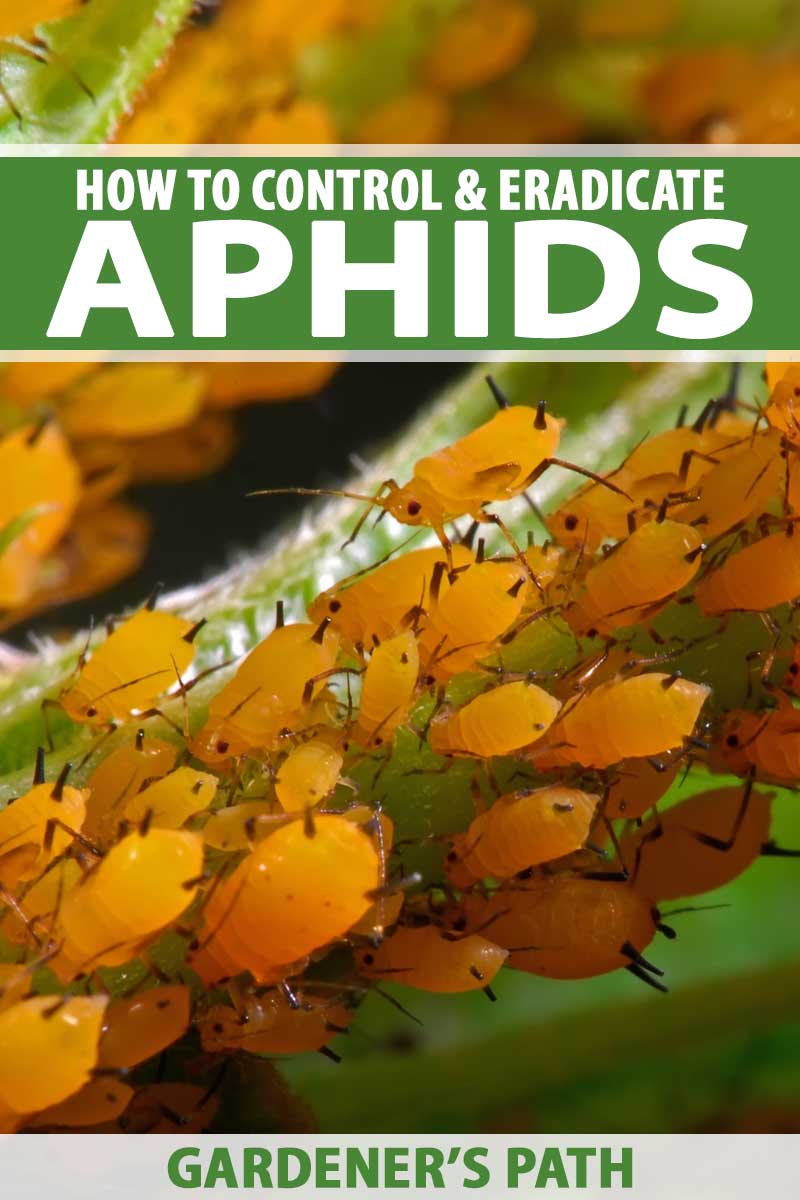
We link to vendors to help you find relevant products. If you buy from one of our links, we may earn a commission.
Let’s take a close look at this destructive pest, beginning with its intriguing characteristics, and concluding with measures for deterring and eradicating it in your garden.
What You’ll Learn
A Fascinating Foe
While I’ve battled plenty of colonies of aphids on my rosebushes with applications of soapsuds and endless streams of water, I knew very little about them until I did some research.

Per Rodale’s Ultimate Encyclopedia of Organic Gardening, a favorite resource of mine that is available on Amazon, the aphid is one of the top 10 insect pests.
An infestation begins innocently enough. A winged female scout flies around looking for a “host” plant to provide food and a place to reproduce. Using a mouth part called a “stylet,” she probes a stem or leaf to see if it’s got what she seeks. If not, she moves on. And, much like Typhoid Mary, may transmit viruses from plant to plant in her search.
Once established, a colony multiplies rapidly. All species reproduce by asexual reproduction, and some also by sexual means. And what I find most astonishing is that if a plant becomes too overcrowded and food is becoming scarce, females with wings are produced deliberately for the purpose of finding new homes for even more insects.

The good news, per the College of Agriculture, Food and Environment Department of Entomology at the University of Kentucky, is that while a plant may look bad, aphid feeding generally will not seriously harm healthy, established trees and shrubs.
And, at least once in history, an aphid-transmitted virus made a lot of money for some lucky horticulturists.

In Life in the Garden, a fun read that’s available from Amazon, author Penelope Lively tells of a time in the 1630s when tulips were all the rage.
It seems that a white species of the flower would occasionally “break,” or bloom with red striations. The rarity and novelty of its occurrence made the price of bulbs soar to the point that one was traded for a house!
What caused the unique color patterns? It took until the 1920s to determine that they were the fortuitous byproduct of a virus transmitted by the peach-potato aphid!
And if that’s not amazing enough, here’s more:
This tiny pest excretes a sweet, sticky substance called honeydew that collects on foliage, inhibiting photosynthesis and making plants vulnerable to a disease called sooty mold.
This sap is a favorite food of the big-headed ant, Pheidole megacephala. It lives in a symbiotic relationship with the aphid, herding it like cattle, milking it for its honeydew, and protecting it from predators.
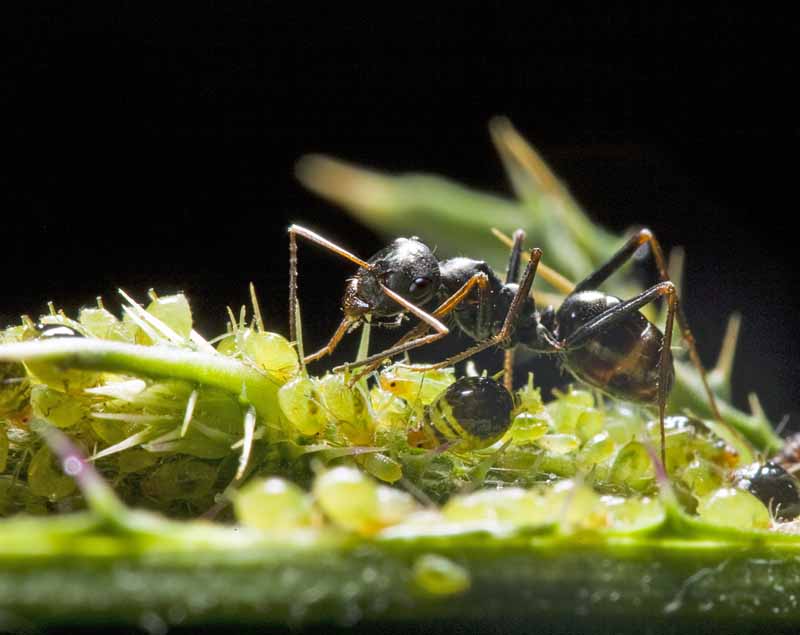
The European yellow meadow ant, Lasius flavus, has similar habits, farming root aphids below the soil for a steady honeydew supply, and occasional consumption of the bugs themselves.
How could such a nuisance of a pest be so fascinating?!
Natural Deterrents
While I admire the survival instincts of this pervasive garden insect, it’s still a pest I don’t want in my yard.
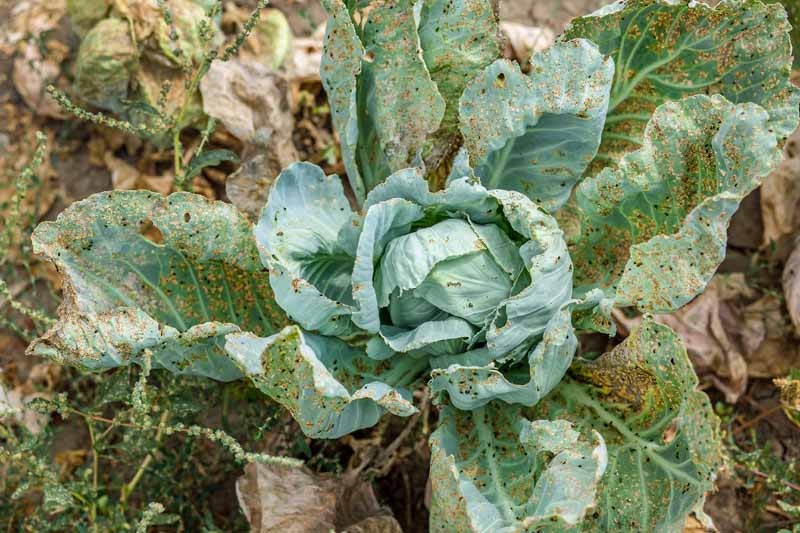
It isn’t a beneficial pollinator, and its very presence exposes my plants to disease and damage.
So, setting aside my inner entomologist, I find ways to make my backyard less appealing to this unwelcome visitor, and stop it in its tracks when it gets a notion to stay.
Healthy Plants
The best way to inhibit pests and disease in the garden is to start with healthy plants or good quality seed, and to maintain them with good care.
Know your plants’ needs, and water properly so they don’t become oversaturated or dry out. Provide adequate air circulation by thinning seedlings and setting plants so air flows through and around them, preventing humidity buildup.
Introduction of Predators
Horticulturist and author Sharon Lovejoy has many clever suggestions for gardeners in her book, Trowel and Error, available from Amazon. This is a sweet little volume full of colorful drawings that I received as a gift.

Trowel and Error: Over 700 Organic Remedies, Shortcuts, and Tips for the Gardener
Lovejoy suggests encouraging “aphid lions,” the larvae of the lacewing, and “aphid wolves,” the larvae of ladybird beetles, to take up residence.
Each feeds voraciously on our pest, and the lady beetles continue to feast on them as mature insects. Borage is a favorite breeding place of the lacewing, and dill, fennel, coreopsis, and cosmos attract ladybugs.
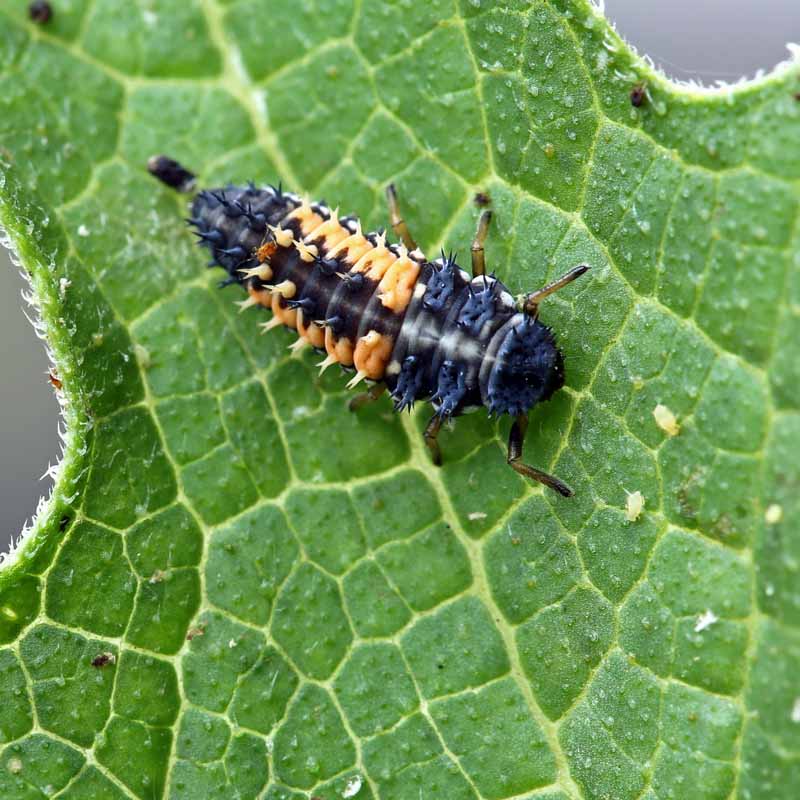
Aphids dislike dill and fennel, so you pack a powerful punch when you plant these aromatic herbs among your ornamental specimens and veggie crops.
Dill attracts the braconid wasp, a beneficial insect. Its larva mummifies an aphid so it can pupate and feed until it matures and flies away.
You may attract a host of beneficial insects by planting nectar-rich native flower species. An added benefit of natives is that they are usually the healthiest plants, being acclimated to their environment.
And finally, birds are an insect predator, so a few bird feeders and a refreshing birdbath can go a long way toward inviting more ready, willing, and able helpers to your backyard.
Companion Planting
You may be able to keep our hungry pest away from prized specimens in two ways. One is to plant something the bugs really like, like nasturtiums, next to a plant you love. This is called a trap crop.
Another is to surround ornamental specimens with something they hate, like catnip.
This technique may not always work, as there are some species of aphids that feed on only one kind of plant, while other species like a variety.
Shelter Gardening
A good way to inhibit insects from settling on your edible plants is to place floating row covers over crops like berry bushes and veggies.
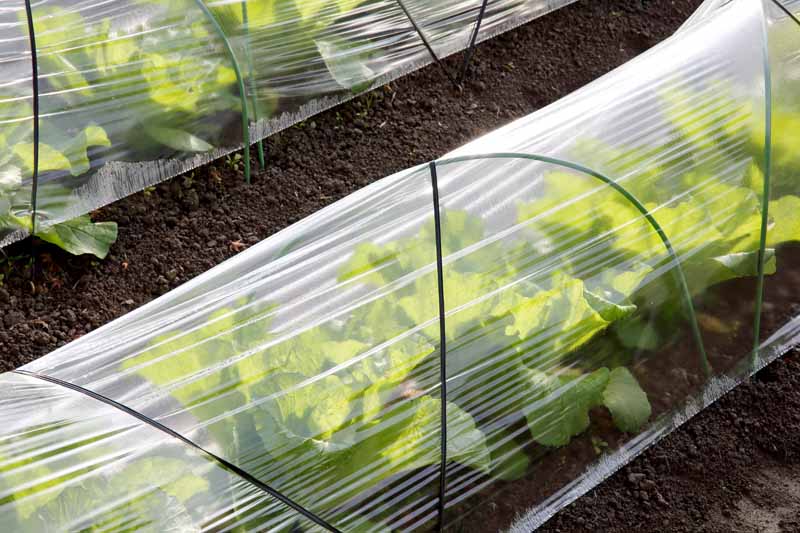
Another is by growing in a greenhouse. And for an additional safeguard, you can introduce ladybird larvae there with little fear they’ll fly away at maturity.
Be sure to look for ones that have been raised in captivity rather than ladybugs collected from the wild and shipped elsewhere.
When all it takes is one insect to start trouble, it pays to take precautions!
Natural Eradication
Sometimes, no matter how hard you try, plants become infested.

However, if you take frequent walks through your yard, you’re bound to notice eggs before they hatch, and insects before they multiply.
When you see a few of either, simply pinch them off. Make it a daily practice, and you may never need to do more.
Sticky Solutions
Lovejoy recommends using sticky tape to “blot” up insects, and it works on eggs, too.
Now, this may seem tedious, but if your infestation is limited to one or two plants, it’s a great method to ensure that none, or at least very few, have escaped your notice.

Trapro 20-Pack Dual-Sided Yellow Sticky Traps for Flying Plant Insects
You may also try a fly-paper type of product, like Trapro’s Dual-Sided Sticky Traps, available from Amazon in 10-, 20-, and 30-pack sizes.
Each strip is bright yellow, and measures 8 x 6 inches. The bright yellow color attracts a host of insects. The only problem here is that you may destroy beneficial ones as well as pests.
A Steady Stream of Water
You may be able to wash away your problem by using a simple sprayer and water hose.
Dislodging insects with a water wand type of spray nozzle is ideal when the stream is strong enough to knock the bugs off, but not so intense that it damages plants. The best kind can be angled to spray the undersides of leaves.

A firm spray should kill aphids on contact, however, be careful not to blast them from one plant to another, as any survivors will have a whole new plant to infest!

The Relaxed Gardener Watering Wand
You may like the Relaxed Gardener Watering Wand, available from Amazon. With eight adjustable spray settings, you’re bound to find one that’s just right.
Horticultural Oil
It’s best to use horticultural oil at the first sign of infestation. Test the spray on a leaf before dousing an entire plant. Heed package warnings about not using it on certain sensitive plants, those that are stressed from transplanting, or any already wilting from disease or pests.
One type is neem oil, a naturally-derived pesticide made from the pressed seeds of the neem evergreen tree, Azadirachta indica.

Organic Neem Bliss 100% Pure Cold Pressed Neem Seed Oil
Neem oil is available from Amazon in ready-to-spray and concentrated forms.

Mother Earth Monterey Horticultural Oil
Other products are comprised mainly of mineral oil, like Mother Earth Monterey Horticultural Oil, available from Amazon. It contains mostly mineral oil and comes in concentrated form in one-quart bottles.
Soap Suds and Insecticidal Soap
Lovejoy also tells us that since our garden pest likes yellow, filling a yellow pan full of sudsy water and placing it near an infestation may do the trick.
Just a few drops of mild liquid dish detergent in about two cups of water are all you need to lure them away from foliage.
Before using a commercial insecticidal soap product, read the label carefully. Some contain toxic chemicals and harm beneficial insects. The best time to spray is early in the spring, when aphids are just beginning to multiply, and many of our insect friends have not hatched yet.

Safer Brand 5110-6 Insect Killing Soap, 32 oz.
You might like Safer Brand Insect Killing Soap, available from Amazon in 32-ounce spray bottles. Choose one or a six-pack. It may also be used for hydroponic and indoor gardening.
In addition, there are products availble to address not only pests, but fungi as well, like the sooty mold that often results from a buildup of honeydew.

Trifecta Crop Control – ALL-IN-ONE Natural Pesticide, Fungicide, Miticide
For an infestation with blackened leaves, you might try a multi-purpose organic remedy like Trifecta Crop Control, available from Amazon.
Diatomaceous Earth
Food-grade diatomaceous earth is a natural powder derived from the crushed sea-life fossils called diatoms. And while it won’t harm you or your plants, it is deadly to aphids.

Diatomaceous Earth Food Grade Powder
Be sure to wear a mask to prevent inhalation of this fine powder as you sift it over your plants, or mix into water to make a spray solution per package instructions.
Just keep in mind that it is not effective while wet, and adding water may cause clumping as it dries. Reapply after rain or watering.
Diatomaceous earth is available from Harris via Amazon in one-, two-, and five-pound packages.
One potential caveat for this option is that diatomaceous earth is harmful to bees and butterfly larvae, so please consider covering treated plants with netting to deter these beneficial insects while you address an infestation.
Since aphids are usually at their most fierce in spring, and bees are not out in force until later in the growing season, you may not have a problem if you apply it early on.
Nematodes
There is a type of aphid that lives in the soil and feeds on roots, stunting growth and disfiguring foliage from below, unseen from above.
You may get rid of it by adding tiny microscopic worms called nematodes to your soil.

Live Beneficial Nematodes Sf – Fungus Gnat/Rootknot Gall Exterminator
Nematodes are available from Amazon in packages containing 5, 10, 25, 50, and 250 million.
Read more about nematodes with our complete guide here.
Pruning
And finally, if all else fails and the infestation is beyond your control, prune away damaged buds, leaves, and stems.
Feed your plant with a low-nitrogen, slow-release, all-purpose plant food, and hope for the best. Low nitrogen levels in the soil inhibit the growth of excess foliage that is attractive to aphids.
In dire circumstances, you may need dig up entire plants and throw them in the trash – not the compost pile – to slow the spread of an infestation on your property.
Types of Aphids
There are over 4,000 species of aphid in a variety of colors. Most attack tender stems and leaves, but some feed on woody stems or roots. You may know this pest by one of its common names, greenfly or blackfly.

There are many species found around the world. The feeding, egg laying, and virus transmission of Pemphigus populi causes damaging growths, or “galls,” to form on foliage.
Other species that gardeners battle daily are the blackfly, Aphis fabae, yellow Aphis nerii that prefers milkweed and oleander, and brown Toxoptera citricida that lives on citrus crops.
There are also the gray cabbage variety, Brevicoryne brassicae, white and fuzzy Eriosomatinae, and the one I usually find here in the Northeast, the green peach, aka peach-potato type, Myzus persica.
And let’s not forget the root aphid, especially the pesky lettuce root variety, Pemphigus bursarius.
As you can see, this is a vast genus of insects. It contains some species that eat one type of plant and others that eat a variety, including vegetables, ornamentals, and trees.
Armed and Ready
Aphid eggs can winter over and hatch out as winged females in the spring. Offspring born during the summer months don’t hatch from eggs. They are born live, ready to devour their plant hosts.
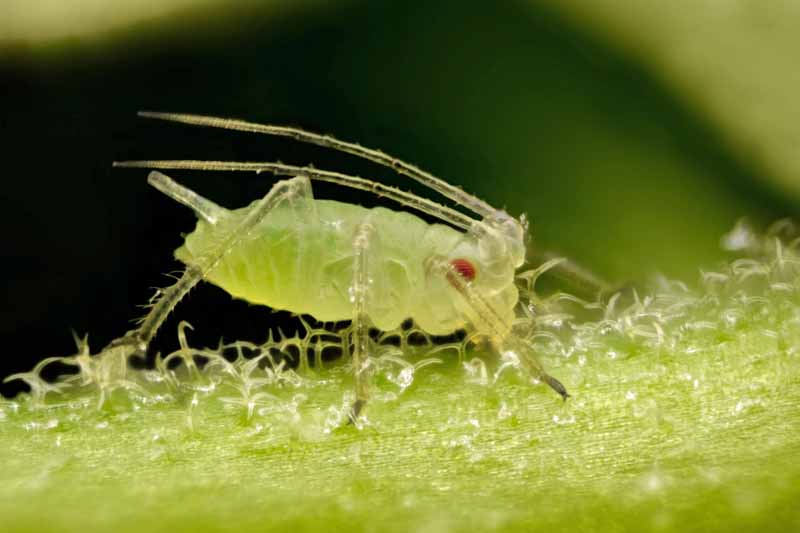
An aphid infestation can destroy the plants you’ve worked so hard to cultivate. Aren’t you glad you’re ready to show them who’s boss?
Let’s recap:
As fascinating as the aphid is, it can destroy plants if left unchecked. Those least likely to suffer are mature, healthy ones, especially native species.
To inhibit an infestation, introduce predators and the foliage they thrive on, employ a strategy of companion planting, or consider shelter gardening, with added protection for plants.
Walk your grounds daily and pinch off any eggs or aphids you spot.
To remediate an infestation, try sticky solutions, a steady stream of water, horticultural oil, soap suds or insecticidal soap, diatomaceous earth, beneficial nematodes for the root variety, or pruning.
And if all else fails, remove a severely infested and damaged plant from the garden and dispose of it in the trash.
It’s time to go outside and see if any pests are setting up housekeeping in the yard, but before you do, here’s one final point – per The Journal of Allergy and Clinical Immunology, some folks may be allergic to aphids. If you have allergic tendencies like me, wear a mask when dealing with them.
Have you managed aphids in your yard? Tell us your tips in the comments section below, and feel free to post photos!
Got the bug bug? To learn even more about pests in the garden, add these articles to your reading list next:
- How to Control Ants in and Around Your Home
- Getting a Grip on Flea Beetles
- Doing Battle with Japanese Beetles: Tips for Banning Them from Your Garden
© Ask the Experts, LLC. ALL RIGHTS RESERVED. See our TOS for more details. Product photos via Amazon. Uncredited photos: Shutterstock.
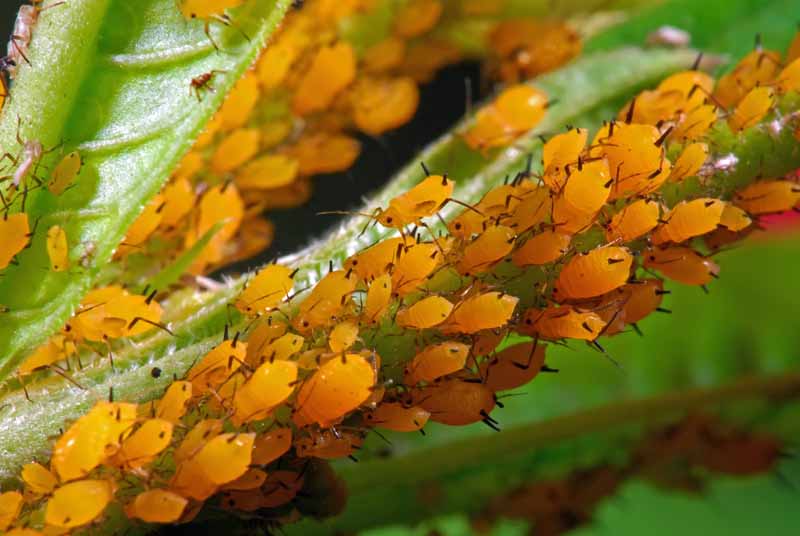
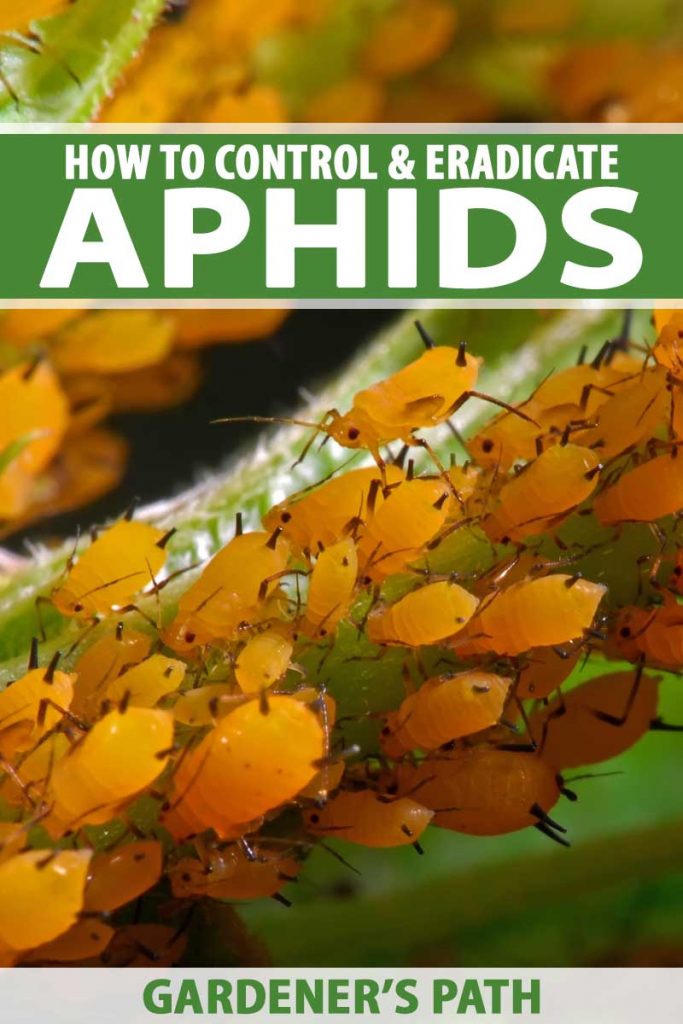
your website is awesome. I read 2 times good work
Thank you for reading!
Thank you for this helpful, very well explained information. I have a small townhouse garden that I squeeze all I can into. Aphids confuse me, this article is very clarifying, i have a much better understanding now of whats going on. Thank you!
We’re so glad to help, Adriana!
Thanks for sharing information with us regarding pest control, I really found this very helpful and interesting. And your blog also taught us many things about the things that we should keep in our mind before using pest control.
We’re so glad to provide information you can use, Rohit!
This text is very well written. I tried spraying aphids on my elder tree with my own mix of oil, hand soap and water. It looks like it works but only like 10-20% of aphids are killed. My whole tree is covered with black aphids. But it is interesting that elder tree that is next to it is not attacked by same aphids. After reading your text, i think it may be attacked soon, because i saw some aphids with wings, those are probably female looking for another plant to attack. I hope oil mix work next time i spray,… Read more »
Hello Jakov –
We are glad you enjoyed the article. Your mixture of soap, water, and oil sounds like an excellent approach. However, if you find it to be ineffective, and the elder becomes infested as well, you may want to give neem oil or an insecticidal soap a try before resorting to deep pruning.
Now, i don’t see any aphids on that elder tree, and i only sprayed once with oil,soap water mix. I don’t know if they are gone because of weather or because it is sprayed with oil/soap. Anyway thanks for advice. I will keep track of what is going to happen next time when i have a same aphid problem , and then i will see if it is succesfull as this time.
Do they get on people and we bring them into our house?
Hi Deb –
Excellent question. Aphids are sap-sucking insects that thrive on plant foliage. They pose no threat to humans.
I strongly disagree with your statement that aphids dislike dill. That is the ONLY plant in my garden that is covered with the little pests!
Very helpful, Thank You !
You’re welcome, Priscilla!
wow
Adults may or may not have wings. Most of the aphid species also occur in winged forms, especially when populations are high or during spring and fall. Aphids are mostly found on plants in large numbers since they are capable of rapid population increases.
I have a rooftop garden and for the 2nd yr in a row I have aphids everywhere. I started w neem oil as soon as I spotted them, followed by insecticidal soap, water spray, sticky traps, and just got some diatomaceous earth while waiting for my shipment of lady bugs. I’ve planted dill, cat nip and alliums all in the hopes of deterrence. I just can’t get rid of them. Do I throw all of my plants away??